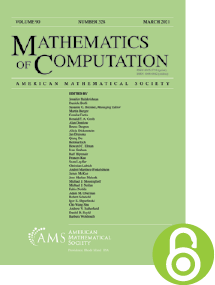Collective marking for adaptive least-squares finite element methods with optimal rates
HTML articles powered by AMS MathViewer
- by Carsten Carstensen HTML | PDF
- Math. Comp. 89 (2020), 89-103 Request permission
Abstract:
All previously known optimal adaptive least-squares finite element methods (LSFEMs) combine two marking strategies with a separate $L^2$ data approximation as a consequence of the natural norms equivalent to the least-squares functional. The algorithm and its analysis in this paper circumvent the natural norms in a div-LSFEM model problem with lowest-order conforming and mixed finite element functions and allow for a simple collective Dörfler marking for the first time. A refined analysis provides discrete reliability and quasi-orthogonality in the weaker norms $L^2\times H^1$ rather than $H(\operatorname {div})\times H^1$ and replaces data approximation terms by data oscillations. The optimal convergence rates then follow for the lowest-order version from the axioms of adaptivity for the newest-vertex bisection without restrictions on the initial mesh-size in any space dimension.References
- P. Binev, W. Dahmen, and R. DeVore, Adaptive finite element methods with convergence rates, Numerische Mathematik 97 (2004), 219–268, DOI 10.1007/s00211-003-0492-7.
- Pavel B. Bochev and Max D. Gunzburger, Least-squares finite element methods, Applied Mathematical Sciences, vol. 166, Springer, New York, 2009. MR 2490235, DOI 10.1007/b13382
- Daniele Boffi, Franco Brezzi, and Michel Fortin, Mixed finite element methods and applications, Springer Series in Computational Mathematics, vol. 44, Springer, Heidelberg, 2013. MR 3097958, DOI 10.1007/978-3-642-36519-5
- Dietrich Braess, Finite elements, 3rd ed., Cambridge University Press, Cambridge, 2007. Theory, fast solvers, and applications in elasticity theory; Translated from the German by Larry L. Schumaker. MR 2322235, DOI 10.1017/CBO9780511618635
- Susanne C. Brenner and L. Ridgway Scott, The mathematical theory of finite element methods, 3rd ed., Texts in Applied Mathematics, vol. 15, Springer, New York, 2008. MR 2373954, DOI 10.1007/978-0-387-75934-0
- P. Bringmann, C. Carstensen, and G. Starke, An adaptive least-squares FEM for linear elasticity with optimal convergence rates, SIAM J. Numer. Anal. 56 (2018), no. 1, 428–447. MR 3757107, DOI 10.1137/16M1083797
- C. Carstensen, M. Feischl, M. Page, and D. Praetorius, Axioms of adaptivity, Comput. Math. Appl. 67 (2014), no. 6, 1195–1253. MR 3170325, DOI 10.1016/j.camwa.2013.12.003
- C. Carstensen, D. Gallistl, and M. Schedensack, Discrete reliability for Crouzeix-Raviart FEMs, SIAM J. Numer. Anal. 51 (2013), 2935–2955, DOI 10.1137/130915856.
- Carsten Carstensen and Friederike Hellwig, Constants in discrete Poincaré and Friedrichs inequalities and discrete quasi-interpolation, Comput. Methods Appl. Math. 18 (2018), no. 3, 433–450. MR 3824773, DOI 10.1515/cmam-2017-0044
- C. Carstensen and F. Hellwig, Optimal convergence rates for adaptive lowest-order discontinuous Petrov-Galerkin schemes, SIAM J. Numer. Anal. 56 (2018), 1091–1111, DOI 10.1137/17M1146671, https://doi.org/10.1137/17M1146671.
- C. Carstensen and E.-J. Park, Convergence and optimality of adaptive least squares finite element methods, SIAM J. Numer. Anal. 53 (2015), 43–62, DOI 10.1137/130949634.
- C. Carstensen, E.-J. Park, and P. Bringmann, Convergence of natural adaptive least squares finite element methods, Numer. Math. 136 (2017), 1097–1115, DOI 10.1007/s00211-017-0866-x.
- C. Carstensen and H. Rabus, Axioms of adaptivity with separate marking for data resolution, SIAM J. Numer. Anal. 55 (2017), no. 6, 2644–2665. MR 3719030, DOI 10.1137/16M1068050
- C. Carstensen and J. Storn, Asymptotic Exactness of the least-squares finite element residual, SIAM J. Numer. Anal. 56 (2018), 2008–2028, DOI 10.1137/17M1125972, https://doi.org/10.1137/17M1125972.
- J. M. Cascon, C. Kreuzer, R. H. Nochetto, and K. G. Siebert, Quasi-optimal convergence rate for an adaptive finite element method, SIAM J. Numer. Anal. 46 (2008), 2524–2550, DOI 10.1137/07069047X.
- Daniele Antonio Di Pietro and Alexandre Ern, Mathematical aspects of discontinuous Galerkin methods, Mathématiques & Applications (Berlin) [Mathematics & Applications], vol. 69, Springer, Heidelberg, 2012. MR 2882148, DOI 10.1007/978-3-642-22980-0
- Rob Stevenson, Optimality of a standard adaptive finite element method, Found. Comput. Math. 7 (2007), no. 2, 245–269. MR 2324418, DOI 10.1007/s10208-005-0183-0
- Rob Stevenson, The completion of locally refined simplicial partitions created by bisection, Math. Comp. 77 (2008), no. 261, 227–241. MR 2353951, DOI 10.1090/S0025-5718-07-01959-X
Additional Information
- Carsten Carstensen
- Affiliation: Institut für Mathematik, Humboldt-Universität zu Berlin, Unter den Linden 6, D-10099 Berlin, Germany
- Email: cc@math.hu-berlin.de
- Received by editor(s): February 24, 2018
- Received by editor(s) in revised form: November 23, 2018
- Published electronically: September 4, 2019
- Additional Notes: This work was supported in the project Foundation and application of generalized mixed FEM towards nonlinear problems in solid mechanics (CA 151/22-2) by the DFG via the priority program 1748 Reliable Simulation Techniques in Solid Mechanics, Development of Non-standard Discretization Methods, Mechanical and Mathematical Analysis
- © Copyright 2019 American Mathematical Society
- Journal: Math. Comp. 89 (2020), 89-103
- MSC (2010): Primary 65N30, 65N12, 65N15
- DOI: https://doi.org/10.1090/mcom/3474
- MathSciNet review: 4011536


